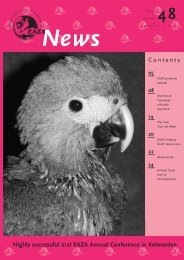EAZA News 57-12 - European Association of Zoos and Aquaria
EAZA News 57-12 - European Association of Zoos and Aquaria
EAZA News 57-12 - European Association of Zoos and Aquaria
You also want an ePaper? Increase the reach of your titles
YUMPU automatically turns print PDFs into web optimized ePapers that Google loves.
The disadvantage <strong>of</strong> heterotrophic bacteria is the production <strong>of</strong> large<br />
amounts <strong>of</strong> extra-cellular biomass. The filter easily clogs if it is not<br />
cleaned on a regular basis. Secondly, part <strong>of</strong> the produced biomass may<br />
exit the filter <strong>and</strong> foul the aquarium water. Extra filtration with a protein<br />
skimmer <strong>and</strong> a mechanical filter such as a s<strong>and</strong> filter may be necessary.<br />
The positive side <strong>of</strong> this type <strong>of</strong> filter is the easy regulation <strong>of</strong> its activity<br />
via the amount <strong>of</strong> incoming ethanol. Though care must be taken when no<br />
nitrate is left <strong>and</strong> ethanol is still dosed, toxic substances like hydrogen<br />
sulphur or sulphite can be produced. The flow through the filter is very<br />
slow (around 150 l/h), making it a system which only has a long-term effect.<br />
The fish aquaria at Burgers’ Ocean are not heavily stocked, to give a<br />
realistic impression <strong>of</strong> a coral reef. Thus food for the fish added to<br />
the aquarium is limited, which in turn limits production <strong>of</strong> nitrate.<br />
The tunnel display for example, is fed with 25 kg wet weight per week.<br />
Nitrate levels have been kept constant with the denitrification filter for<br />
the last three years at 35 mg NO3--N/l, with a 3% water change per year.<br />
Denitrification with elemental sulphur<br />
During the <strong>European</strong> Union <strong>of</strong> Aquarium Curators (EUAC) Conference in<br />
1997, Michel Hignette <strong>of</strong> Aquarium de la Porte Dorée in Paris, presented<br />
a new de-nitrification technique (Hignette et al., 1997). This technique is<br />
based on drinking water filtration, in which the bacteria convert nitrate<br />
<strong>and</strong> elemental sulfur into nitrogen gas <strong>and</strong> sulfate. A disadvantage <strong>of</strong><br />
this technique is that it also produces sulfuric acid, which will deplete<br />
the buffer capacity <strong>and</strong> decrease the pH. This technique is also used at<br />
Burgers’ Ocean to deplete nitrate in fish aquaria.<br />
Sulfur-based denitrification units photo burgers’ zoo<br />
sustainability<br />
Methanol-based denitrification unit photo burgers’ zoo<br />
The effluent <strong>of</strong> the systems has a pH between 6.2 <strong>and</strong> 6.5. To prevent<br />
depletion <strong>of</strong> the pH in the aquaria, this water is first run through a<br />
calcium carbonate or a coral s<strong>and</strong> bed. This increases the pH to between<br />
7.3 <strong>and</strong> 7.6. Burgers’ Ocean uses three parallel columns <strong>of</strong> 300 l each<br />
(including 250 l sulfur) for an aquarium with a volume <strong>of</strong> 600 m3 . The<br />
volume <strong>of</strong> the serial coral s<strong>and</strong> buffers is the same as the sulfur columns.<br />
The flow through the sulfur columns is approximately 150 l/h. During<br />
the three years this filter is used, the nitrate level is kept constant at<br />
40 mg NO3--N/l, with a 4% water change per year <strong>and</strong> a feeding regime<br />
<strong>of</strong> approximately 15 kg wet weight per week.<br />
Phosphate removal<br />
When nitrate levels are controlled by the techniques described earlier, a<br />
second important nutrient like phosphate may become a problem. It is<br />
commonly known that, in low concentrations, phosphates are a problem<br />
to corals (> 0.05 mg PO4 3--P/l). While the effect on fish is unknown it<br />
may also be negative. Therefore, it was decided to look for techniques<br />
to remove phosphates as so little water change takes place. Granulates<br />
work perfectly for small systems, but are extraordinarily expensive to use<br />
in large volumes <strong>of</strong> water.<br />
Aluminium, iron or lanthanum chloride may be better alternatives. These<br />
elements will draw on the phosphates to precipitate into aluminium-,<br />
iron- or lanthanum phosphates. The first pilot experiments with the<br />
non-toxic iron chloride addition look promising. An iron phosphate <strong>and</strong><br />
iron hydroxide complex is formed, which settles down in a settlement tank.<br />
Residuals are filtered out with a high-rate s<strong>and</strong> filter. A disadvantage <strong>of</strong><br />
this is the usage <strong>of</strong> hydroxide <strong>and</strong> thus a decreasing pH. It may therefore<br />
be necessary to increase the pH with a sodium hydroxide or sodium<br />
carbonate addition.<br />
It seems that the techniques described above make it possible to re-use<br />
water in fish aquaria in nearly closed systems. Cascading techniques <strong>and</strong><br />
backwashing s<strong>and</strong> filters with freshwater help keep the seawater usage<br />
to a minimum. It may be necessary to apply other techniques at Burgers’<br />
Ocean in the future, if other problems relating to the small amount <strong>of</strong><br />
water change appear. •<br />
eaza news <strong>57</strong><br />
2007<br />
15

















